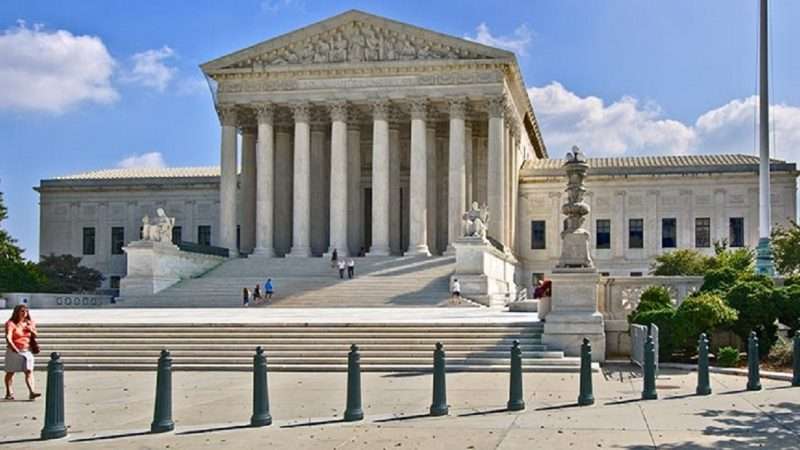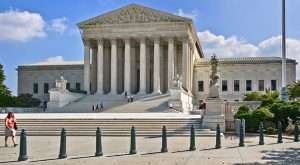Please enjoy the latest edition of Short Circuit, a weekly feature from the Institute for Justice.
Friends, Tuesday April 20 is the 150th anniversary of President Grant signing the Civil Rights Act of 1871 into law, giving the federal government powerful tools to fight the Ku Klux Klan—and giving civil rights plaintiffs a powerful tool, Section 1983, to hold state and local officials accountable for violating the Constitution. Please join us on Zoom from 12 – 2 pm ET for an event commemorating this momentous occasion and featuring scholars and litigators including Paul Finkelman, Fred Smith, Kelsi Brown Corkran, and Victor Fleitas. Register today!
- “For the second time,” notes the D.C. Circuit, “we face the question of what to do about a Guantanamo military commission judge who, while presiding, seeks employment with an entity involved in prosecuting the detainee.” But because the government was willing to let any allegedly tainted orders be reconsidered de novo, the D.C. Circuit sees no need to weigh in; the detainee’s petition for a writ of mandamus is denied.
- Despite the COVID-19 pandemic, the speaker of the New Hampshire House of Representatives refuses to allow members to participate in votes remotely (the previous Speaker died of COVID-19 one week after being selected at an in-person gathering). Seven House members with various medical conditions sue, alleging the policy violates the Americans with Disabilities Act. First Circuit: Quite possibly. The case is remanded for reconsideration of the plaintiffs’ motion for preliminary injunction.
- Allegation: Suspected drug dealer flees across rooftops from Reading, Penn. police and is eventually cornered in an abandoned building. Unarmed and covered in his own blood, he dangles himself out a window. An officer punches him repeatedly in the head. He falls 10 feet and breaks his leg. Though he’s unconscious, another officer tases him. District court: Qualified immunity. Third Circuit: Not so. Remanded for trial.
- Do you like puzzles? Then you’ll love the Fifth Circuit‘s 325-page set of en banc opinions on the lawfulness and constitutionality of the Indian Child Welfare Act, the law that regulates the placement and adoption of children born to American Indians. Some of the Act violates equal protection, some violates the anticommandeering doctrine, and some violates the Administrative Procedure Act. But, other parts do not. Want to know which parts do and don’t and why? You can only really figure that out by adding up the various votes and comparing numerous footnotes in the several opinions. However, the court helpfully includes a five-page per curiam cheat sheet to get you started.
- Sole black member of a jury—in a case involving a Heritage Creek, Ky. police officer allegedly body-slamming a black man in because he was in the wrong place at the wrong time—reveals that the white jurors wrote off the plaintiff as a crack addict and referred to his lawyers as “the Cosby Show.” Sixth Circuit: Courts generally cannot consider evidence of jury deliberations, but the Supreme Court has made an exception for evidence of racial bias. Today, we hold that exception applies to civil as well as criminal trials.
- South Dakota man spends 10 years in prison for vehicular homicide after he rolls his Corvette, killing the passenger. Whoops! Witnesses later confirm that he was the passenger and the dead woman was the driver. He’s released and sues, alleging that the reckless investigation by the trooper who found him violated his constitutional rights. Eighth Circuit: The trooper found the victim on the passenger side of the car and the plaintiff outside the car near the open driver-side door, and the witnesses didn’t come forward until years later. It’s hard luck, but it doesn’t shock the conscience.
- Lee County, Iowa officer who is transporting a handcuffed and shackled but not seatbelted prisoner in his cruiser responds to bank robbery in progress. Prisoner: The officer drove through a rutted, unmaintained lot, tossing me around violently and causing injuries to my neck and back. Officer: I was only going 20 to 25 mph, though I did turn abruptly when the robber fired at the cruiser. District court: A jury should sort this out. Eighth Circuit: Reversed. The officer may have been negligent, but negligence isn’t enough to impose liability here.
- Can a grocery store be held liable under the ADA because its website is not accessible to the visually impaired? Eleventh Circuit: Nope. A website is not itself a place of public accommodation under the ADA, and the website’s limited functionality does not prevent visually impaired customers from visiting the physical store. While the Ninth Circuit reached a contrary decision in a case involving a pizza chain, that case was distinct because customers could order pizza on the website. Dissent: Even if customers couldn’t buy anything on the website, they could use it to refill prescriptions and access coupons. As stores make increasing use of the internet, they need to make their websites accessible to the visually impaired.
- Two Tallahassee police officers kill armed suspects in separate encounters. Can the city publicly identify the cops? Florida appellate court: No. The suspects threatened the cops’ lives, thus victimizing them, so the cops are entitled to Florida constitutional protections that allow crime victims to remain anonymous.
- There’s a lot to untangle in this Kansas Supreme Court decision about statutory rape between two underage teens. But the takeaway is we can all rest assured that Clay County, Kan. officials are committed—really, really committed—to prosecuting a 14-year-old girl for having sex with a 14-year-old boy (who was older than her by several months).
- And in en banc news, the Ninth Circuit has amended but will not reconsider its decision enjoining in all states along the southern border the Trump Administration’s rule requiring asylum seekers to first apply for, and be denied, asylum in a country they had to travel through to get to the southern border.
Elizabeth Brokamp is a licensed, certified, and very experienced counselor who has been providing therapy over the internet to clients from her home in the Virginia suburbs of Washington D.C. throughout the pandemic. One of her clients moved to New York, however, which bars out-of-state counselors from providing teletherapy. Though the state has temporarily waived its ban, it will soon become illegal for Elizabeth to continue. Interestingly, if she had no qualifications whatsoever, New York would allow her to work as an unlicensed “life coach.” But precisely because of her extensive training, her speech is verboten. That’s an irrational and unconstitutional restriction on Elizabeth’s First Amendment rights, so this week she joined with IJ to sue New York. Click here to read more. (Elizabeth is also challenging a similar restriction in D.C. that bars her from taking on new clients.)
from Latest – Reason.com https://ift.tt/3d3NfBi
via IFTTT





